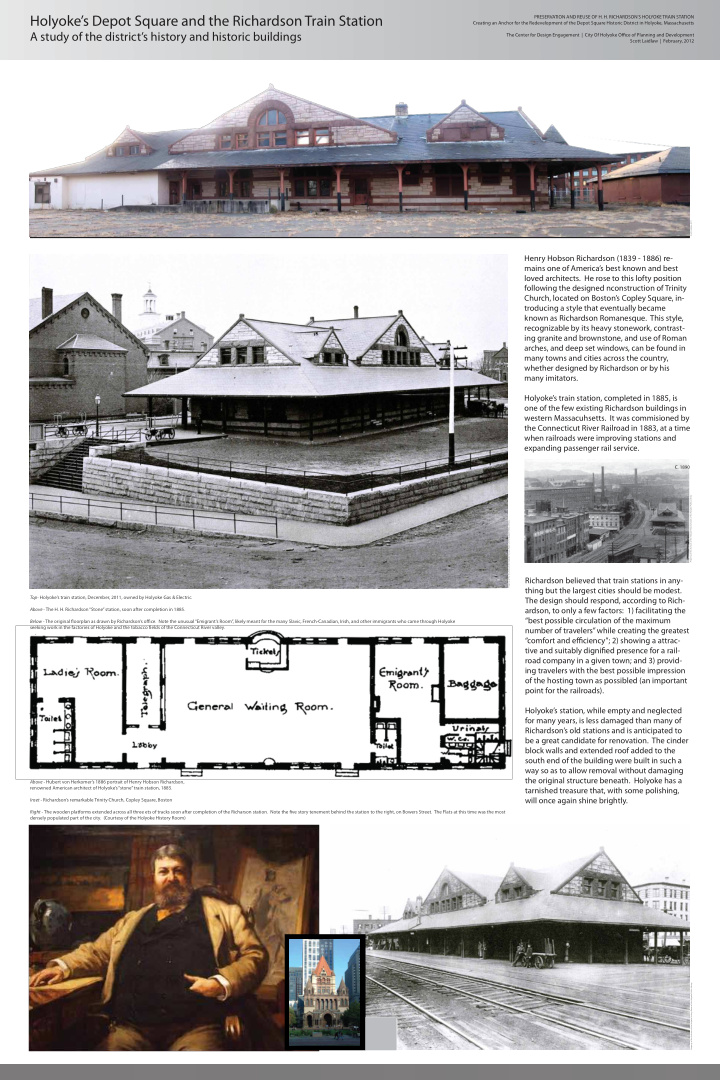



Holyoke’s Depot Square and the Richardson Train Station PRESERVATION AND REUSE OF H. H. RICHARDSON’S HOLYOKE TRAIN STATION Creating an Anchor for the Redevelopment of the Depot Square Historic District in Holyoke, Massachusetts A study of the district’s history and historic buildings The Center for Design Engagement | City Of Holyoke Office of Planning and Development Scott Laidlaw | February, 2012 Scott Laidlaw, 2011 Henry Hobson Richardson (1839 - 1886) re- mains one of America’s best known and best loved architects. He rose to this lofty position following the designed nconstruction of Trinity Church, located on Boston’s Copley Square, in- troducing a style that eventually became known as Richardson Romanesque. This style, recognizable by its heavy stonework, contrast- ing granite and brownstone, and use of Roman arches, and deep set windows, can be found in many towns and cities across the country, whether designed by Richardson or by his many imitators. Holyoke’s train station, completed in 1885, is one of the few existing Richardson buildings in western Massacuhsetts. It was commisioned by the Connecticut River Railroad in 1883, at a time when railroads were improving stations and expanding passenger rail service. C. 1890 Property of the Archives of the Holyoke History Room of the Holyoke Public Library Property of the Archives of the Holyoke History Room of the Holyoke Public Library Richardson believed that train stations in any- thing but the largest cities should be modest. Top - Holyoke’s train station, December, 2011, owned by Holyoke Gas & Electric. The design should respond, according to Rich- Above - The H. H. Richardson “Stone” station, soon after completion in 1885. ardson, to only a few factors: 1) facilitating the “best possible circulation of the maximum Below - The original floorplan as drawn by Richardson’s office. Note the unusual “Emigrant’s Room” , likely meant for the many Slavic, French-Canadian, Irish, and other immigrants who came through Holyoke seeking work in the factories of Holyoke and the tobacco fields of the Connecticut River valley. number of travelers” while creating the greatest “comfort and efficiency”; 2) showing a attrac- tive and suitably dignified presence for a rail- road company in a given town; and 3) provid- ing travelers with the best possible impression of the hosting town as possibled (an important point for the railroads). Holyoke’s station, while empty and neglected for many years, is less damaged than many of Richardson’s old stations and is anticipated to be a great candidate for renovation. The cinder block walls and extended roof added to the south end of the building were built in such a way so as to allow removal without damaging the original structure beneath. Holyoke has a Above - Hubert von Herkomer’s 1886 portrait of Henry Hobson Richardson, renowned American architect of Holyoke’s “stone” train station, 1885. tarnished treasure that, with some polishing, will once again shine brightly. Inset - Richardson’s remarkable Trinity Church, Copley Square, Boston Right - The wooden platforms extended across all three ets of tracks soon after completion of the Richarson station. Note the five story tenement behind the station to the right, on Bowers Street. The Flats at this time was the most densely populated part of the city. (Courtesy of the Holyoke History Room) Property of the Archives of the Holyoke History Room of the Holyoke Public Library
Recommend
More recommend